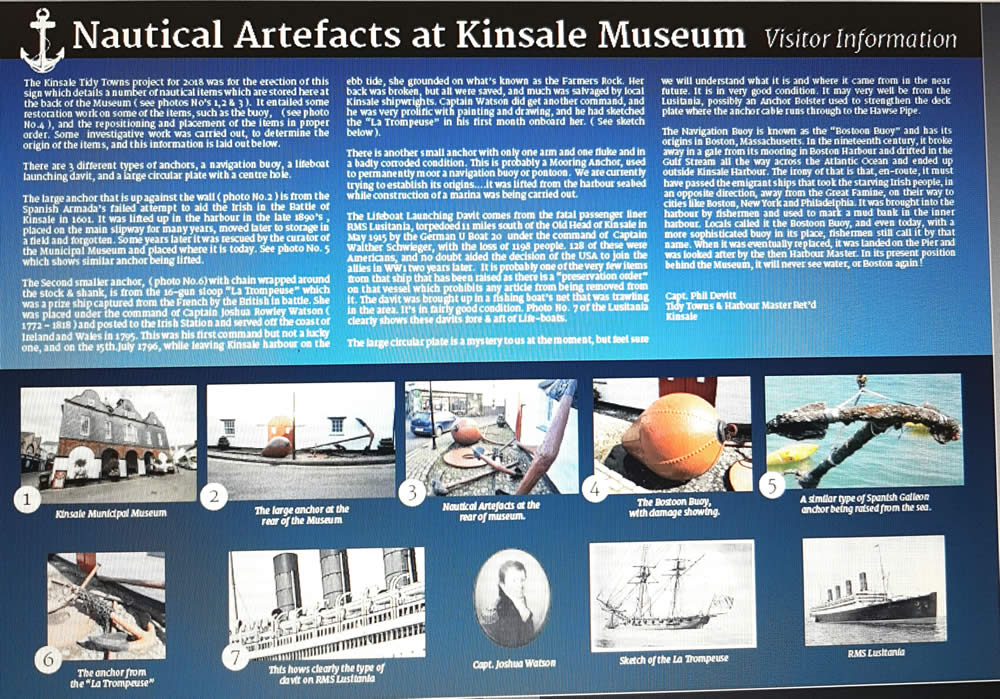Nautical Artifacts at Kinsale Museum 2018

The Kinsale Tidy Towns project for 2018 involves a number of nautical items which are stored at the back of the Museum ( see photos No’s 1,2 & 3 ). This will entail restoration work on some of the items, such as the buoy, ( see photo No.4 ), the erection of an information stand, and the repositioning and placement of the items in proper order. Some more investigative work needs to be carried out, although some has been under-taken to date and it is laid out below.
There are 3 different types of anchors, a navigation buoy, a lifeboat launching davit, and a large circular plate with a centre hole.
The large anchor that is up against the wall ( photo No.2 ) is from the Spanish Armada’s failed attempt to aid the Irish in the Battle of Kinsale in 1601. It was lifted up in the harbour in the late 1890’s , placed on the main slipway for many years, moved later to storage in a field and forgotten. Some years later it was rescued by the curator of the Municipal Museum and placed where it is today. It requires some cleaning & painting. See photo No. 5 which shows similar anchor being lifted.
The Second smaller anchor, ( photo No.6) with chain wrapped around the stock & shank, is from a 16-gun sloop “La Trompeuse” which was a prize ship captured from the French by the British in battle. She was placed under the command of Captain Joshua Rowley Watson ( 1772 – 1818 ) and posted to the Irish Station and served off the coast of Ireland and Wales in 1795. This was his first command but not a lucky one, and on the 15th.July 1796, while leaving Kinsale harbour on the ebb tide, she grounded on what’s known as the Farmers Rock. Her back was broken, but all were saved, and much was salvaged by local Kinsale shipwrights. Captain Watson did get another command and was very prolific with painting and drawing, and he had sketched the “La Trompeuse” in his first month onboard her.
There is another small anchor with only one arm and one fluke and in a badly corroded condition. This is probably a Mooring Anchor, used to permanently moor a navigation buoy or pontoon. We are currently trying to establish its origins….it was lifted from the harbour seabed while construction of a marina was being carried out.
The Lifeboat Launching Davit comes from the fatal passenger liner RMS Lusitania, torpedoed 11 miles south of the Old Head of Kinsale in May 1915 by the German U Boat 20 under the command of Captain Walther Schwieger, with the loss of 1198 people. 128 of these were Americans, and no doubt aided the decision of the USA to join the allies in WW1 two years later. It is probably one of the very few items from that ship that has been raised as there is a “preservation order” on that vessel which prohibits any article from being removed from it. The davit was brought up in a fishing boat’s net that was trawling in the area. It’s in fairly good condition. Photo No. 7 of the Lusitania clearly shows these davits fore & aft of Life-boats.
The large circular plate is a mystery to us at the moment, but feel sure we will understand what it is and where it came from by the time we have finished our project. It is in very good condition. It may very well be from the Lusitania, possibly an Anchor Bolster used to strengthen the deck plate where the anchor cable runs through to the Hawse Pipe.
The Navigation Buoy is known as the “Bostoon Buoy” and has its origins in Boston, Massachusetts. In the nineteenth century, it broke away in a gale from its mooring in Boston Harbour and drifted in the Gulf Stream all the way across the Atlantic Ocean and ended up outside Kinsale Harbour. The irony of that is that, en-route, it must have passed the emigrant ships that took the starving Irish people, in an opposite direction, away from the Great Famine, on their way to cities like Boston and New York. It was brought into the harbour by fishermen and used to mark a mud bank in the inner harbour. Locals called it the Bostoon Buoy, and even today, with a more sophisticated buoy in its place, fishermen still call it by that name. When it was eventually replaced, it was landed on the Pier and was looked after by the then Harbour Master. In its present position behind the Museum, it requires refurbishing (see photo No.6) and this work will commence in early 2018.
Some Related Images
QUICK LINKS
- Bandon Road Project (2022)
- Pledge your garden to pollinators
- Bird Box Project
- Wildflower Garden (2019)
- Nautical Artefacts at Kinsale Museum
- The Famine Graveyard (2017)
- Marine Park (2016)
- Garden of Rememberance
- Cast Bronze Walled Town
- Super Valu Tree Planting
- The Old Pound
- Meadow Lawn
- The Abbey Well
- Friary Avenue





